Johnson Bombers
How the game of baseball brought unexpected recognition and honors to a modest Jamaica Plain man, George T. “Red” Johnson, and his namesake team, the Johnson Bombers. 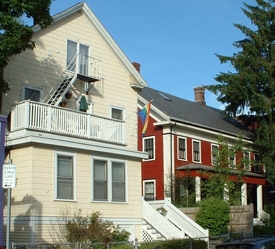 In 1874 the first standardized baseballs were manufactured at 39 Green Street, Jamaica Plain, by Louis Mahn. Photograph by Charlie Rosenberg.Special thanks to Joe Davis, former Johnson Bombers (baseball) and Johnson Classics (basketball) player who suggested this story and assisted with the research.
In 1874 the first standardized baseballs were manufactured at 39 Green Street, Jamaica Plain, by Louis Mahn. Photograph by Charlie Rosenberg.Special thanks to Joe Davis, former Johnson Bombers (baseball) and Johnson Classics (basketball) player who suggested this story and assisted with the research.
By Peter O’Brien
December, 2012
Baseball in Jamaica Plain Jamaica Plain’s baseball history goes way back to 1871, when Harry Wright and his brother, George, founded the Boston Red Stockings. The Red Stockings later became the Boston Braves. The Wrights were English cricket players who came to America and switched to baseball. Harry lived for a time on Pond Street, Jamaica Plain, and was an early inductee to the Baseball Hall of Fame.
Jamaica Plain’s baseball history goes way back to 1871, when Harry Wright and his brother, George, founded the Boston Red Stockings. The Red Stockings later became the Boston Braves. The Wrights were English cricket players who came to America and switched to baseball. Harry lived for a time on Pond Street, Jamaica Plain, and was an early inductee to the Baseball Hall of Fame.
In 1874 the first standardized baseballs were manufactured at 39 Green Street, Jamaica Plain, by Louis Mahn. Mahn later sold the patent for the ball to Albert G. Spalding, a co-founder of the National League in 1876 and founder of the sporting goods firm that still bears his name.
Leo Callahan was born in Jamaica Plain in 1890. He played from 1913 to 1919 for the Brooklyn Dodgers and Philadelphia Phillies.
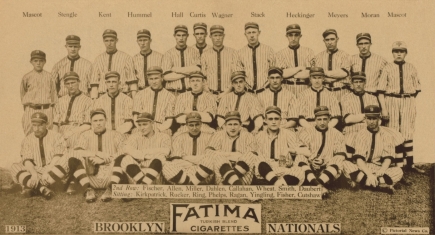 1913 Brooklyn Nationals. Leo Callahan is shown fifth from left in middle row of seated players.
1913 Brooklyn Nationals. Leo Callahan is shown fifth from left in middle row of seated players.
Babe Twombley was born in Jamaica Plain in 1896 and he played with the Chicago Cubs in 1920.
Johnnie Tobin was born in Jamaica Plain in 1906 and he played in 1932 for the New York Giants with just one major league at bat. 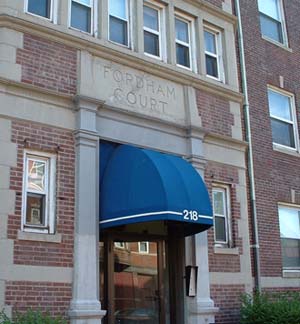 Fordham Court Apartments owned by Joseph Lanin in 1914In 1914 the owner of the Boston Red Sox, Joseph Lannin, owned the apartment complex known as Fordham Court on South Street, Jamaica Plain. There were rumored, but unconfirmed, reports of occupancy in the apartments by Tris Speaker and Babe Ruth.
Fordham Court Apartments owned by Joseph Lanin in 1914In 1914 the owner of the Boston Red Sox, Joseph Lannin, owned the apartment complex known as Fordham Court on South Street, Jamaica Plain. There were rumored, but unconfirmed, reports of occupancy in the apartments by Tris Speaker and Babe Ruth.
In 1929, the year the Boston Park League was started, St. Thomas of Jamaica Plain was the first League champion; a feat St. Thomas repeated again in 1931 and 1932. 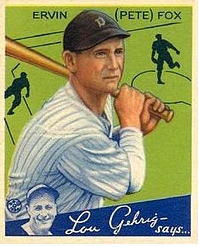 Courtesy of WikipediaErvin Pete Fox, former Red Sox player, lived on Carolina Avenue, Jamaica Plain, for a time in the 1950s. He often attended our CYO ball games at Murphy Playground on Carolina Avenue, Jamaica Plain, wearing the old-style Red Sox jacket.
Courtesy of WikipediaErvin Pete Fox, former Red Sox player, lived on Carolina Avenue, Jamaica Plain, for a time in the 1950s. He often attended our CYO ball games at Murphy Playground on Carolina Avenue, Jamaica Plain, wearing the old-style Red Sox jacket.
Eddie Waitkus of Cambridge, also known as “the natural,” played for the Phillies, Cubs and Orioles in the 1940s and 1950s. Waitkus was the victim of a shooting which is dramatized in Robert Redford’s movie, The Natural. Waitkus survived the shooting and lived until 1972 in Jamaica Plain.
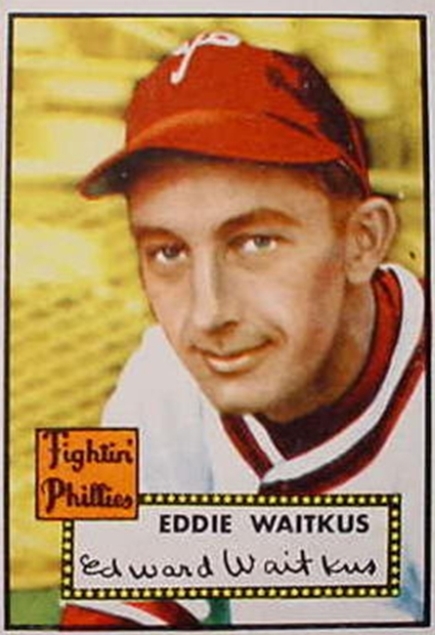 Eddie Waitkus
Eddie Waitkus
And then comes Red Johnson and his Johnson Bombers.
George T. “Red” Johnson
Red Johnson is a legend in the Boston Park League where his love of baseball, his players and the team he founded, the Johnson Bombers, consumed all of his free time and a good chunk of his hard-earned salary. We’re not sure when Red was bitten with the baseball bug, but he was driven to personally sponsor, fund and manage his teams over most of the 30 years he was active in the Boston Park League. He won a seventh-grade baseball award at the Agassiz School – perhaps that’s where it started?
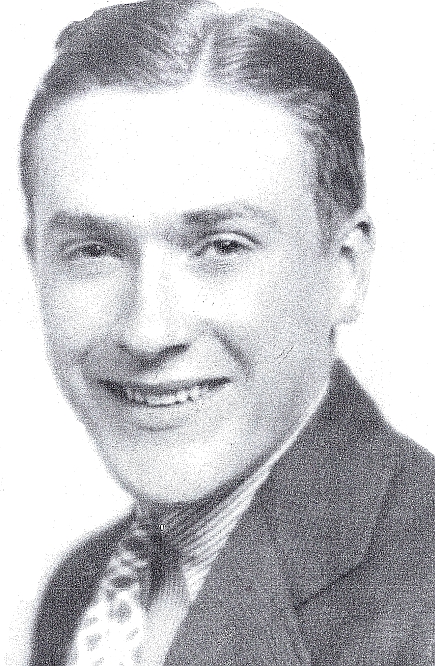 George T. “Red” Johnson. Date unknown. Courtesy of Mrs. Catherine Johnson.
George T. “Red” Johnson. Date unknown. Courtesy of Mrs. Catherine Johnson.
While never winning a Park League baseball championship, Red did bring home the gold in basketball, coaching the Johnson Classics to a championship season in the City Basketball League in 1962. In the end, and perhaps better than a winning baseball career, the “Red Johnson Alumni Award,” presented each year since 1982 by the Boston Park League to a selected former player, would please Red more than a shelf full of trophies. And his election to the Park League Hall of Fame that same year would be the ultimate recognition of his many years of helping to keep the league alive.
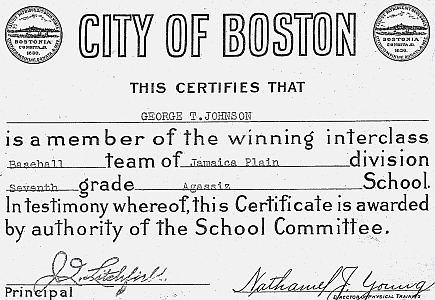 Red’s seventh grade Agassiz School award. Courtesy of Mrs. Catherine Johnson.
Red’s seventh grade Agassiz School award. Courtesy of Mrs. Catherine Johnson.
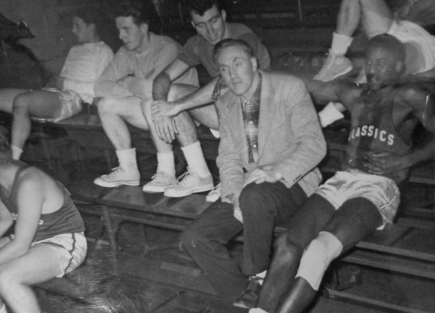 Red Johnson in civvies. Courtesy of Joe Davis.
Red Johnson in civvies. Courtesy of Joe Davis.
The Boston Park League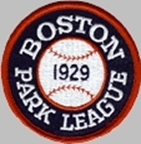 Boston Park League logo, courtesy of Boston Park League.The Boston Park League was founded in 1929 by Bob Cusick, program director for the Boston Parks and Recreation Department, and it is now the nation’s oldest amateur baseball league. It was Cusick’s idea for the City of Boston to support and manage a quality amateur baseball league, and have most of the City represented. Teams were sponsored by different individuals, businesses, and churches. He bought discarded Red Sox and Braves uniforms and hired unemployed professional umpires at three dollars a game, and was able to field ten teams to begin the Boston Senior Park League.
Boston Park League logo, courtesy of Boston Park League.The Boston Park League was founded in 1929 by Bob Cusick, program director for the Boston Parks and Recreation Department, and it is now the nation’s oldest amateur baseball league. It was Cusick’s idea for the City of Boston to support and manage a quality amateur baseball league, and have most of the City represented. Teams were sponsored by different individuals, businesses, and churches. He bought discarded Red Sox and Braves uniforms and hired unemployed professional umpires at three dollars a game, and was able to field ten teams to begin the Boston Senior Park League.
The popular league was highly publicized and games were well attended. In the 1930s and 1940s, it was not unusual to see 3,000 to 5,000 fans show up for a regular season game. At play-off time, the attendance would increase from 8,000 to 12,000 a game, and it is reported that one game at Fallon Field in 1933 drew 18,000 to see the Roslindale Town Team beat the Rosebuds.
The Boston Park League drew praise from such notables as Judge Kenesaw Mountain Landis, Commissioner of Major League Baseball from 1920 to 1944, who said it was “the best operated municipal baseball organization in America.” He demonstrated his support by attending the 1932 Boston Park League banquet along with other prominent baseball personalities.
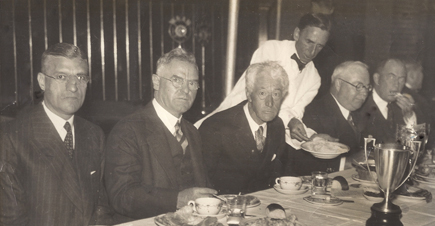 1932 Boston Park League Banquet. From L to R: American League President Will Harridge, Red Sox owner Bob Quinn, Commissioner of Baseball Judge Kenesaw Mountain Landis, Boston Parks Commissioner William Long, Boston Director of Recreation, William Mullen. Courtesy Mrs. Joan (Cusick) Morrissey
1932 Boston Park League Banquet. From L to R: American League President Will Harridge, Red Sox owner Bob Quinn, Commissioner of Baseball Judge Kenesaw Mountain Landis, Boston Parks Commissioner William Long, Boston Director of Recreation, William Mullen. Courtesy Mrs. Joan (Cusick) Morrissey
In the 1950s and 1960s, the League continued to draw 6,000 or more fans to post-season playoff games. These were the most productive years. Despite the leveling of attendance, the League continued to prosper as a steady stream of skilled players were coming and going. The players came from high schools, colleges and the professional ranks. The latter’s professional experience and skills influenced many a ballplayer to play in the best league around.
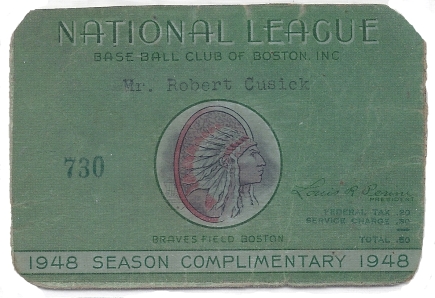 Bob Cusick’s Braves Field pass. Courtesy of Mrs. Joan (Cusick) Morrissey.
Bob Cusick’s Braves Field pass. Courtesy of Mrs. Joan (Cusick) Morrissey.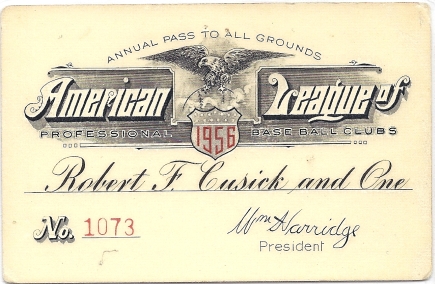 Bob Cusick’s Pass to All American League Ballparks. Courtesy of Mrs. Joan (Cusick) Morrissey
Bob Cusick’s Pass to All American League Ballparks. Courtesy of Mrs. Joan (Cusick) Morrissey
Over the years there have been several distinct Park League levels. While the criteria are lost to us, we know there were seven other levels besides the Senior Park League. They were: Industrial, City National, City American, Hub, Suburban, Dorchester and Business leagues.
In 1982 the City of Boston decided to transfer the League’s administrative duties to a small group of former players and coaches. The league named Bill Mahoney its first President, Harvey Soolman Secretary-Treasurer, and Walt Mortimer Umpire-in-Chief. Walt Mortimer is currently Secretary-Treasurer. With the need for more funding, the Budweiser Brewing Company of Medford sponsored the League for four years. The Yawkey Foundation came on board in 1986 and has continuously sponsored the Boston Park League to the present. Much more information about the Boston Park League can be found at their website, www.bostonparkleague.org.
Bob Cusick
Robert F. Cusick was born in 1907 in Fall River, Mass. He died, aged 82, in 1989. He attended Durfee High School where he played basketball, graduating in 1925. In 1929 he went to work for the Boston Parks Department under Parks Commissioner William Mullen. Soon after joining the City’s Parks Department, Cusick’s proposal for a Boston Park League was approved and he proceeded to set it up and preside over it from his office at the Pinebank Mansion on Jamaica Pond, until retiring in 1976 as Director of the Boston Parks and Recreation Department. Known as a “helluva guy” by Joe Cronin, Bob Cusick was the confidant of Ted Williams, Tom and Jean Yawkey, and other members of the Red Sox family for many years. He was known far and wide in professional baseball as “Mr. Baseball,” and was the owner of annual complimentary passes to all American League ballparks for many years.
Bob raised his family in West Roxbury, relocating to Cape Cod after he retired. Shortly after his retirement, Mayor Kevin White proclaimed September 12, 1976 as Bob Cusick Day, and named the baseball diamond on Boston Common, at Boylston and Charles Street, for him.
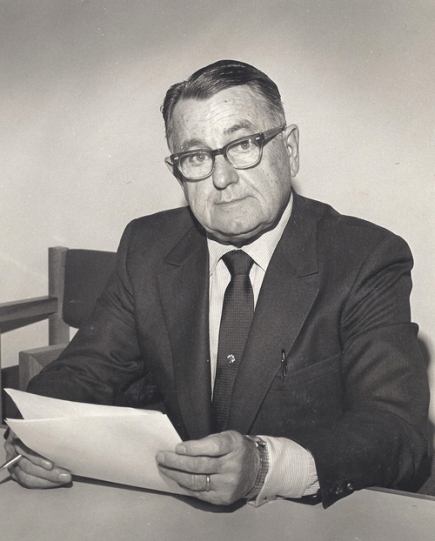 Bob Cusick, Director Boston Parks and Recreation Department. Courtesy of Mrs. Joan (Cusick) Morrissey
Bob Cusick, Director Boston Parks and Recreation Department. Courtesy of Mrs. Joan (Cusick) Morrissey
Countless thousands of Boston’s young and not-so-young men have found an organized outlet for their baseball “field-of-dreams” in the Boston Park League. They played for well over 100 different teams with the caliber of play at the top levels good enough to attract former and future professional players. Indeed, many former Park League players were signed by major-league scouts. Bob Cusick’s vision for amateur baseball in Boston was certainly fulfilled, and the present Park League administration continues that vision for Boston’s young men.
Until budget cuts in 1981, the City provided well-maintained fields, night-game lighting, paid umpires and a minimal level of equipment. Thereafter, the teams had to pay the umpires and an assessment for use of the fields. While now self-sustaining with the generous help of the Yawkey Foundation, it is interesting to note that the chairman of the Yawkey Foundation, John Harrington, and Bob Cusick’s daughter, Joan Morrissey of Norwood, are year-apart graduates of St. Thomas Aquinas High School in Jamaica Plain.
Red Johnson’s Beginnings
In researching this story, several of Red’s former players were interviewed. Few, if any, knew much about Red’s personal life, only baseball anecdotes related to his teams and players. The answer is simple; he never spoke about himself, his work, his family or his own playing days – it was always about the game of baseball and his players.
Red was born on February 8, 1914, in Dorchester. His parents were from Nova Scotia. He died in Boston of a heart attack at age 73 on December 11, 1987. Although he had moved to Newton in 1984, he was buried from St. Thomas Aquinas Church in Jamaica Plain on December 14, 1987. He is buried in plot 117 at The Gardens of Gethsemane Cemetery, 670 Baker Street in West Roxbury.
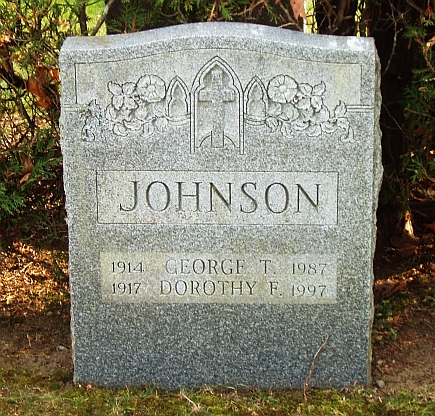 Red’s Gravesite at Gardens of Gethsemane Cemetery. Photograph courtesy of Peter O’Brien.
Red’s Gravesite at Gardens of Gethsemane Cemetery. Photograph courtesy of Peter O’Brien.
After 181 Sidney Street, Dorchester, Red is next reported, in 1930, at 3 Woolsey Square, Jamaica Plain. He married the former Dorothy F. Chaperon of Vermont and they lived from 1935 to 1940 at Vernon Street in Roxbury with his in-laws. During that period he was listed as an unemployed road laborer. From 1950 to 1960 the Johnsons lived at 2 Alfred Street in Jamaica Plain, until moving to 70 Green Street, just down the street from the home of the first standard major-league baseballs made a hundred years earlier, at 39 Green Street, Jamaica Plain. They next lived at 6 Everett Street, Jamaica Plain, until 1974. In 1981 they were located at 84 Dunster Road, Jamaica Plain, and in 1984 the Johnsons moved to 677 Winchester Street in Newton.
Red went to the Agassiz school in Jamaica Plain and completed two years of high school according to census records. He had two brothers, Joseph and Arthur, and both are deceased. Joseph was killed in action in WWII. The playground at the corner of Lamartine and Green Streets was named for Corporal Joseph E. Johnson in a 1960 ceremony with Mayor John Collins. Arthur Johnson’s widow, and Red’s sister-in-law, Catherine, who is shown in the Collins photo, graciously provided many of the photos in this piece.
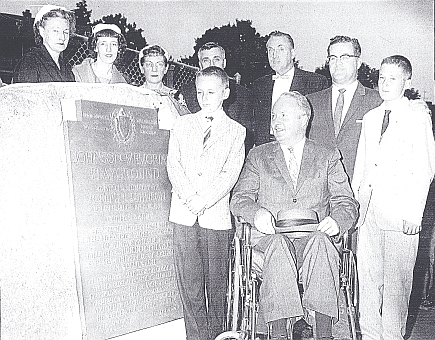 Mayor John Collins dedicating Johnson Playground. Rear L to R: Dorothy, Catherine, Helen, Arthur, and Red Johnson, Rep. James Craven, Joseph Johnson, a nephew. Another nephew, Robert Johnson, stands at the right of Mayor Collins. Courtesy Mrs. Catherine Johnson, the source of the clipping is unknown.Coach Johnson
Mayor John Collins dedicating Johnson Playground. Rear L to R: Dorothy, Catherine, Helen, Arthur, and Red Johnson, Rep. James Craven, Joseph Johnson, a nephew. Another nephew, Robert Johnson, stands at the right of Mayor Collins. Courtesy Mrs. Catherine Johnson, the source of the clipping is unknown.Coach Johnson
We think Red began his Park League coaching career about 1949 with a team called Trimont Tool. Trimont Manufacturing Company was located at 55-71 Amory Street in the old Rockland Brewery building from about 1902 to 1954. Trimont made heavy-duty wrenches and other pipe-fitting tools. They held several patents for wrenches and other devices. Trimo wrenches are EBay collectibles nowadays.
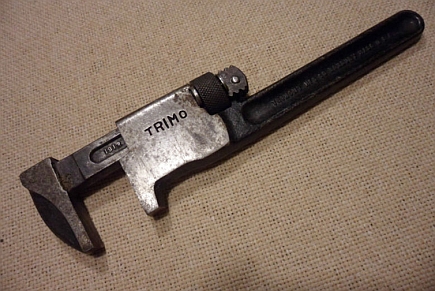 Trimo wrench. Courtesy of Fort Hill History by Jason Turgeon.
Trimo wrench. Courtesy of Fort Hill History by Jason Turgeon.
At some point Red negotiated blue-on-blue uniforms and limited support from the Company for his Trimont Tool team which was probably in the Industrial League, a notch or two below the Caseys, Royals, Saints, Crosbys, Crownburners, etc. in the Senior Park League. And with money from his own pocket, and occasionally exercising his home team prerogative of passing the hat, he kept us in clean baseballs, and a few un-taped bats. The author’s first hitch with Red was about 1952-3 with the Trimont team. Another contributor, Dick Mazzocca, played for Trimont also. Dick went on for another six years with the Park League’s Crosby Club after we served together in the Army in Japan.
We are guessing the Johnson Bombers was formed shortly before Trimont closed in 1954. This time Red must have dug deep in his own pocket to come up with uniforms as seen in this early Johnson Bombers photo, about 1954. 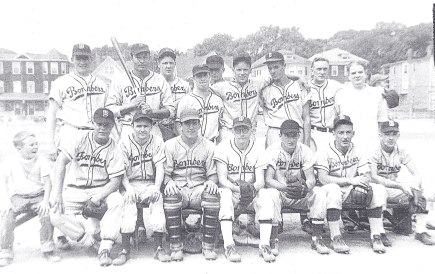 Johnson Bombers about 1954. Courtesy of Mrs. Catherine Johnson.
Johnson Bombers about 1954. Courtesy of Mrs. Catherine Johnson.
There is scant information available about Trimont Tool or the Bombers in the Park League as most records were lost. It is known, however, that despite finishing between fifth and seventh for twenty years, the Bombers had two players who made it to the big leagues: Richie Hebner and Skip Lockwood.
The Players Remember Red
Larry McNulty, a retired teacher/principal/coach, a Park League Hall-of-Famer and former New York Mets player, played for the Johnson Bombers from 1958 to 1961 and for Red’s 1962 championship basketball team, the Johnson Classics. Larry was struck by Red’s love of the game of baseball and his players, and his wife’s devotion to repairing the uniforms kept at their Green Street apartment where Larry visited frequently. Noting that Red never spoke about himself, Larry did, however, visit him at work at Beth Israel Hospital where Red was so obviously conscientious. “He was an inspirational leader, if not the most astute baseball coach.” He would, Larry recalls, wear out the grass at the third-base coach’s box as he exhorted the batter to “give-it-a-ride, give-it-a-ride.” Most importantly though, without children of his own, Red seemed to adopt his players and treated them like they were his own kids. He was one-of-a-kind.
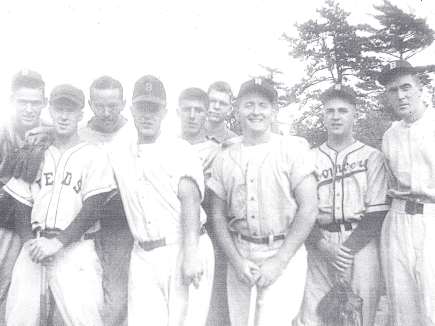 Red Johnson on far right with unnamed players. Courtesy of Mrs. Catherine Johnson.
Red Johnson on far right with unnamed players. Courtesy of Mrs. Catherine Johnson.
Jack Fahey, 83, of West Roxbury, played 26 years in the Boston Park League and was the 2011 Red Johnson Alumni Award recipient, and is another Park League Hall-of-Famer. Jack didn’t play for Red but knew him well and has heard many of the anecdotes connected with Red. He believes Red had a great eye for talent, excellent organizing skills (including finding sponsors), but Red’s baseball-managing skills were somewhat less, and so he never won a championship in the League. Jack recalled how Red enlisted Joe Coleman Sr., former Philadelphia Athletics pitcher, to manage the Johnson Bombers starting on May 11, 1959 at Fallon Field. Joe pitched an occasional game as well, and later managed the athletic programs at Walpole and Norfolk State prisons. Red also enlisted Gerry Leone, later coach at Franklin High School, who played until an ankle injury ended his playing days. Gerry’s son is now Middlesex County’s District Attorney. Jack also recalled Ornie Woods, a carpet layer, as another talented player Red recruited. And there were many others. Jack also visited Red’s apartment on Green Street and remembers the Bombers’ equipment neatly stored in barrels and boxes.
Joe Davis of Groveland lived on Forbes Street, Jamaica Plain, from 1959 to 1966. A retired Amtrak detective, he recalls playing baseball for the Johnson Bombers and basketball for the Johnson Classics in 1959-61, before entering the Army. His most vivid memory of Red is as a father figure to him and many others who played for him. Red loved baseball talk and remembering other players he had coached, easily recalling their names and particular baseball skills. Years after his Army service, Joe spotted Red at Fallon Field one evening and went over to say hello and Red greeted him like a long-lost son. Joe visited Red’s Green Street apartment also and saw the neatly-stored equipment and uniforms there. Joe’s class of 1958 at Jamaica Plain High has many friends of Red’s too, including Gerry Burke of Doyle’s Café. Red’s reputation carried him far and wide in Jamaica Plain.
Dick Mazzocca of Walpole is a retired Norwood business man and an eight-year Park League veteran from Jamaica Plain. He played for Red’s Trimont Tool team, and following his Army service in Japan, Dick returned to the Park League’s Crosby Club for six more years. Dick’s lasting memory of Red was his complete absorption with the game of baseball and his unabashed enthusiasm for each game, despite a pretty steady diet of losses. Dick says, however, Red never quit – he didn’t have it in him to quit.
Harvey Soolman of Medford won the Red Johnson Alumni Award in 2004. Harvey has been involved with the Park League for over 40 years as a player, coach and administrator. He is also a published playwright and an accountant. Harvey didn’t know Red but was playing while Red’s Bombers were still active and he remembers Red’s practice of driving around with give-away baseballs.
Boston Globe Newspaper Clippings
August 22, 1947. The Casey Club wons its opener with the Linehan Club, 3-1, before 5,000 at South Boston Stadium. Catcher Red Johnson drove in a single with a line drive to left field. Later, Johnson contributed a sparkling play to prevent a Linehan rally.
May 11, 1959. The Park League opened its 29th season that evening with former major leaguer Joe Coleman and George “Red” Johnson at the helm of the Johnson Bombers against the Boston Selkirks at Fallon Field, Roslindale.
March 30, 1961. Larry McNulty scored 31 points to lead the Johnson Classics to a 104-86 win over the Waltham Boy’s Club in the Class A semi-final of the 19th annual Waltham Boy’s Club Basketball Tournament.
March 31, 1961. The Wells Club of Somerville won the chance to meet the Boston Park League Basketball Champs, the Johnson Classics, in the finals.
March 20, 1962. Bill Foley and Bill Donovan led Newtondale Drug to a 115-89 Class A victory over the Johnson Classics at the Waltham Boy’s Club Basketball Tournament.
March 24, 1962. George Schlenhuber and Lennie Sorrin led the Johnson Classics to an 89-50 triumph over the Huntington YMCA in the 20th annual Waltham Boys Club Basketball Tournament at the Waltham Boy’s Club gym.
May 13, 1962. As the 32nd Park League season opened, the Johnson Bombers, with Red Johnson again handling the club, started a team made up mostly of newcomers against the Bottomly Club of Hyde Park at Fallon Field, Roslindale.
May 20, 1963. The future Mayor of Boston, Ray Flynn, threw a three-hitter against the Johnson Bombers for a 10-1 victory for the Supreme Saints in the first-ever Sunday Park League game.
August 1, 1965. Winning 12 of their last 14 games, the Johnson Bombers would be making the playoffs for the first time in Manager George Johnson’s 16 years of Park League play. The Bombers lost to the Connolly Club 5-1, but managed a 6-4-3 triple play in the game.
June 30, 1968. A lengthy Globe article said that there was no lack of brain power on the Johnson Bombers and the coach, a self-described “truck driver,” was not intimidated by the bright, articulate, kids on his team. On the contrary, they were all comfortable with each other despite a 7-8 record! The story reported the Bombers’ players with Princeton, MIT, Yale, Cornell, Harvard and Northeastern degrees. The degreed players were Phil DeSantis of Roxbury, Avi Nelson of Brookline, Geoff Weissman of New York City, Tom Argir of Natick, Wayne Rana of New York, Jim Hampe of Dedham, John MacGowan of Boston and Skip Cunningham of Boston, who the week before had earned only a tie in a no-hit, no-run game he pitched for the Bombers. Other (then) recent Bomber players included major-leaguer Joe Coleman, Sr., and Richie Hebner, the Norwood star who went on to a great major-league career. Red described himself as head of the motor service at Beth Israel Hospital during the day, while at night he was the Bombers’ owner, general manager, coach, scout, batboy, equipment manager, scorekeeper and groundskeeper.
November 25, 1979. In another lengthy article entitled “Remembering Boston,” several prominent Bostonians, including James Michael Curley, boxer Peter Fuller and other entertainers, remembered Boston. Red Johnson was also interviewed and he observed that after coaching semi-professional baseball for 30 years and playing before coaching, he opted to forego a rocking chair, a pipe and a pair of slippers so he could continue in some other capacity when he retired:
Back when he decided to become a coach, a lot of people told him he was wasting his time in sports and that he was not going to get anywhere. Red said to the reporters interviewing him, “Lookit, Howard Johnson makes twenty-eight flavors because people like different things, just as some of you guys like horses, some of you guys like dogs, some of you like music, and some like art. I happen to like sports and that’s why I’m in it. I didn’t drink, smoke or gamble but I took a liking to sports. Now when I was a youngster, if you went down to the local ballpark there’d be a game going in every corner. You had to get up early in the morning to find a place to play because there was so much interest in baseball. Of course, in those days there was no television, there were no automobiles, no drive-in theaters, and during Prohibition there were no barrooms. In other words, there were fewer things to do, so the youngsters turned to sports if they wanted some action.”
Red said he turned to sports because he liked it and the kids where he was brought up liked it too, and they had some pretty good athletes. Comparing the past with the (then) present, the sportswriters often asked his opinion about the kids he coached in 1979 and the kids he had coached thirty years previous. He told them the only difference was there were too many diversions – too many things for them to do at the present time, so that they tended to branch off into other areas. He thought the only real interest in baseball then (1979) was in the Spanish community, where they were deeply into baseball. When asked to umpire a (then) recent championship playoff series he was impressed with their sincerity compared to the (Caucasian) American kids. The Spanish kids dived into the bases head first and they got very emotional if they didn’t make a hit or if they made an error. He hadn’t seen that kind of enthusiasm for many years. Their genuine interest in baseball was evident when you spoke to them and they would say “viva pelota,” or “long live baseball!”
May 18, 1980. In an article noting the opening of the Park League’s 50th year, Red Johnson was named among the “angels” who kept the league going by running teams practically on their own.
April 1, 1981. An article describing the City’s withdrawal of financial support of the Park League, due to budget cuts, announced that lights would no longer be provided, umpires would be paid by the teams and the teams would be assessed a user’s fee for the use of the fields. Several managers were at a kick-off meeting and aired their concerns, along with their willingness to do whatever it took to keep the league functioning. “Dedication,” said George “Red” Johnson, a 30-year veteran of the league as a player, sponsor and manager. “I can’t refrain from contrasting the attitude of these guys with that of some of the prima donnas we know in higher places.”
Red Johnson at Beth Israel Hospital
Red was a driver/courier for Beth Israel Hospital from 1952 to his retirement in 1976. Their June 1976 internal newsletter, the BI Examiner, memorialized Red’s retirement with glowing tributes from staff and co-workers. Here are some of the accolades: Beth Israel’s talented man about town is retiring and will leave a gap roughly the size of the Grand Canyon. He doesn’t talk much about himself, but no one in the hospital has had such rapport with so many at so many levels. His daily rounds in the ’67 Ford van, in all weather and traffic conditions sometimes totaled fourteen stops, many times picking up snowbound key-employees, emergency lab deliveries, spare parts, the all-important mail and always making friends along the way. His driving skill in delivering a critically ill child to a neighboring hospital for emergency surgery was credited with saving the child’s life, and donning a Santa’s suit when B.I. had an in-patient pediatric unit was just another example of Red’s special concern for children.
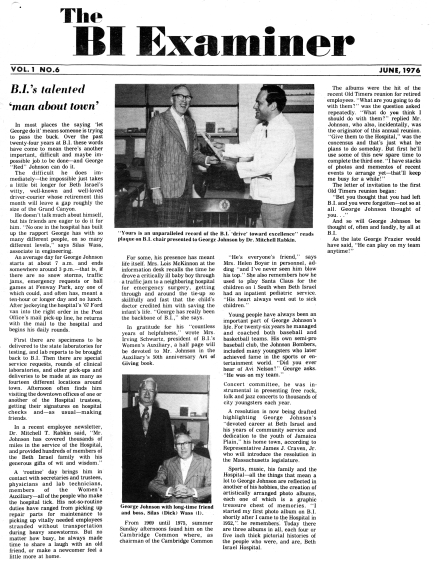 BI Examiner notes Red’s retirement, June 1976. Courtesy the Ruth and David Freiman Archives at Beth Israel Deaconess Medical Center.Another of Red’s avocations was the creation of artistically-arranged photo albums depicting the people who were employed at Beth Israel Hospital. There were three, five-inch thick albums in all, started just after Red was hired at B.I.in 1952. These albums were a hit at each of the Old-Timers reunions he organized for B.I. retirees. Red donated the albums to the hospital.
BI Examiner notes Red’s retirement, June 1976. Courtesy the Ruth and David Freiman Archives at Beth Israel Deaconess Medical Center.Another of Red’s avocations was the creation of artistically-arranged photo albums depicting the people who were employed at Beth Israel Hospital. There were three, five-inch thick albums in all, started just after Red was hired at B.I.in 1952. These albums were a hit at each of the Old-Timers reunions he organized for B.I. retirees. Red donated the albums to the hospital.
At Red’s Beth Israel retirement, Representative James J. Craven introduced a resolution in the Massachusetts Legislature highlighting George Johnson’s “devoted career at Beth Israel Hospital and his years of community service and dedication to the youth of Jamaica Plain,” his hometown. And, in recognition of Red’s service to the hospital, he was presented with an inscribed Beth Israel chair by Dr. Mitchell Rabkin. Red Johnson left a mark on Beth Israel Hospital and he will be thought of, often and fondly, by all at Beth Israel.
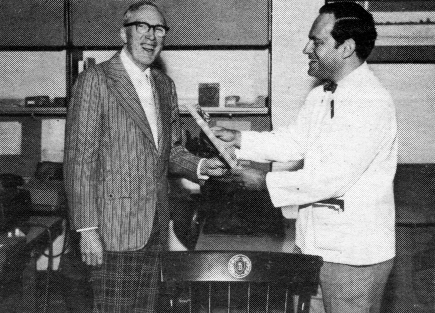 Dr. Mitchell Rabkin presents Red with his Beth Israel chair. Courtesy the Ruth and David Freiman Archives at Beth Israel Deaconess Medical Center.
Dr. Mitchell Rabkin presents Red with his Beth Israel chair. Courtesy the Ruth and David Freiman Archives at Beth Israel Deaconess Medical Center.
Life after Baseball
After retiring from the hospital and baseball, Red devoted himself to entertaining senior citizens at various retirement homes including Farnsworth House at 90 South Street, Jamaica Plain. Red was a one-man band called “Memory Lane Ballroom,” and he’d bring tambourines for the seniors to participate. Soon, true to his coaching instincts, he’d have them up dancing. He performed every Sunday for over ten years and seniors and administrators, including Dean Collotta, Property Manager of Farnsworth House, fondly remember Red Johnson and his tambourines to this day. Coincidentally, Dean Collotta also played in the Boston Park League.
Give-it-a-ride
Red Johnson was obviously a man driven by a love of baseball. And his post-baseball career, entertaining seniors, bespeaks a kind heart, with perhaps a bit of a showman’s love for the spotlight, a spotlight that, sadly, never found him in the winner’s circle in Boston’s amateur baseball world. Nevertheless, those who knew him, or played for or against him, or worked with him, never forgot him. He was truly one-of-a-kind, and he would “give-it-a-ride” in whatever he applied himself to. Jamaica Plain is proud to include his name in its baseball history.
References and Credits
1. Baseball in Jamaica Plain by Michael Reiskind, Jamaica Plain Historical Society.
2. Trimont Manufacturing Co. information courtesy Fort Hill History, a blog about Fort Hill/Highland Park by Jason Turgeon.
3. Boston Park League information courtesy Walt Mortimer and the Boston Park League.
4. Beth Israel “BI Examiner” excerpts courtesy of The Ruth and David Freiman Archives at Beth Israel Deaconess Medical Center and Michael Keating, Manager of Internal Communications, BIDMC.
5. Boston Globe archives, various dates.
6. …and thanks to Dick Mazzocca, Walt Mortimer of the Boston Park League, Harvey Soolman, Jack Fahey, Dean Collotta, Eunace Davis at The Gardens of Gethsemane Cemetery, Larry McNulty, Catherine Johnson, Scott Johnson, Gerry Burke, Joan (Cusick) Morrissey and many other Red Johnson fans.
